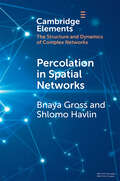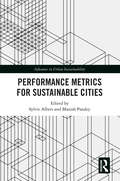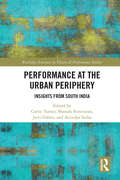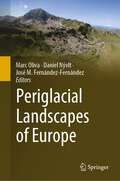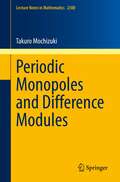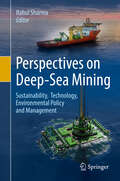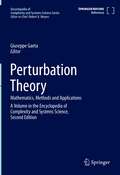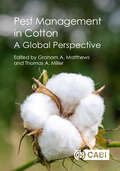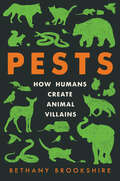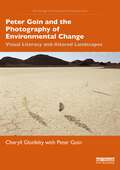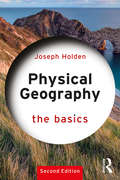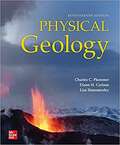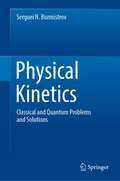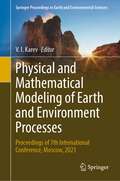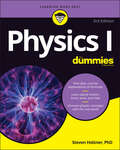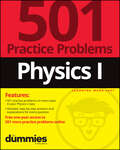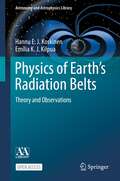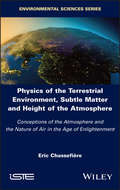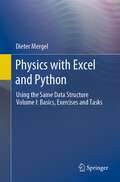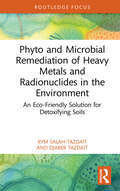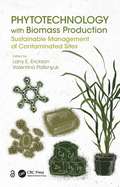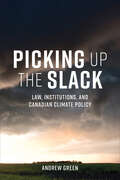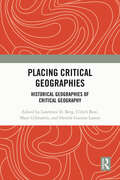- Table View
- List View
Percolation in Spatial Networks: Spatial Network Models Beyond Nearest Neighbours Structures (Elements in Structure and Dynamics of Complex Networks)
by Shlomo Havlin Bnaya GrossPercolation theory is a well studied process utilized by networks theory to understand the resilience of networks under random or targeted attacks. Despite their importance, spatial networks have been less studied under the percolation process compared to the extensively studied non-spatial networks. In this Element, the authors will discuss the developments and challenges in the study of percolation in spatial networks ranging from the classical nearest neighbors lattice structures, through more generalized spatial structures such as networks with a distribution of edge lengths or community structure, and up to spatial networks of networks.
Performance Metrics for Sustainable Cities (Advances in Urban Sustainability)
by SylvieManish Albert PandeyPerformance Metrics for Sustainable Cities provides an overview of measurement systems and tools to enable communities to self-assess and benchmark their progress along a continuum of smart, intelligent, and sustainable development. It begins by explaining the importance of measurement and evaluation for cities and smaller communities, as well as future factors that will need to be considered and embedded into planning processes. Across 14 chapters, the book describes existing evaluation mechanisms that are being used for government funding decisions, awards of recognition, and new measurement systems to assess what makes a city smarter and more sustainable, such as broader sustainable goal targets (UN SDGs), green cities, fabrication cities, and compassionate cities. It presents examples of metrics used for important sustainability and liveability concepts for cities such as how to measure trust, engagement, compassion, circular economy, and so forth. The book ends with reflections on the feasibility of a holistic system of measurement and the implications of its implementation. This volume will be of great interest to students, researchers, and professionals of urban sustainability, planning, smart cities, and sustainable communities.
Performance at the Urban Periphery: Insights from South India (Routledge Advances in Theatre & Performance Studies)
by Anindya Sinha Sharada Srinivasan Jerri Daboo Cathy TurnerThis edited volume considers performance in its engagement with expanding Indian cities, with a particular focus on festivals and performances in Karnataka, Tamil Nadu and Kerala. The editors ask how performance practices are affected by urbanisation, the effects of such changes on their cultural economy, and the environmental impacts of performance itself. This project also considers how performance responds to its context, and the potential for performance to be critical of the city’s development, and of its own compromises. Bringing together perspectives from the humanities, natural and social sciences, the book takes a multi-faceted analytical view of live performance, connecting contemporary with heritage forms, and human with more-than-human actors. The three sections, themed around heritage, everyday life, and future ecologies, will be of great interest to students and scholars in performance, heritage studies, ecology and art history.
Periglacial Landscapes of Europe
by Marc Oliva Daniel Nývlt José M. Fernández-FernándezThis book comprehensively presents the geography of landforms linked to periglacial processes across Europe. The landscape of the European cold climate regions, both at high latitudes and in mountainous environments, represent the lingering, minimal expression of the glaciers. In addition, periglacial elements can be found in temperate regions, where temperatures no longer favor periglacial processes, so landforms are therefore inherited from previous cold phases.The book is divided into five parts: an introductory section on climate variability responsible for periglacial dynamics across Europe; a second part including 3 blocks on periglacial landforms in southern, central and northern Europe; and a final chapter providing a more general perspective on the impact of periglacial processes on the landscape of Europe. The book offers a valuable reference guide for scientists from all disciplines interested in cold climate processes, as well as readers outside academia (territorial managers, environmentalists, mountaineers, politicians, engineers, etc.).
Periodic Monopoles and Difference Modules (Lecture Notes in Mathematics #2300)
by Takuro MochizukiThis book studies a class of monopoles defined by certain mild conditions, called periodic monopoles of generalized Cherkis–Kapustin (GCK) type. It presents a classification of the latter in terms of difference modules with parabolic structure, revealing a kind of Kobayashi–Hitchin correspondence between differential geometric objects and algebraic objects. It also clarifies the asymptotic behaviour of these monopoles around infinity.The theory of periodic monopoles of GCK type has applications to Yang–Mills theory in differential geometry and to the study of difference modules in dynamical algebraic geometry. A complete account of the theory is given, including major generalizations of results due to Charbonneau, Cherkis, Hurtubise, Kapustin, and others, and a new and original generalization of the nonabelian Hodge correspondence first studied by Corlette, Donaldson, Hitchin and Simpson.This work will be of interest to graduate students and researchers in differential and algebraic geometry, as well as in mathematical physics.
Perspectives on Deep-Sea Mining: Sustainability, Technology, Environmental Policy and Management
by Rahul SharmaThis book is a sequel to ’Deep-Sea Mining: Resource Potential, Technical and Environmental Considerations’ (2017) and ‘Environmental Issues of Deep-Sea Mining: Impacts, Consequences and Policy Perspectives’ (2019), and aims to provide a comprehensive volume on different perspectives of deep-sea mining from specialists around the world. The work is timely, as deep-sea minerals continue to enthuse researchers involved in activities such as ascertaining their potential as alternative sources for critical metals for green energy and other industrial applications, as well as technology development for their sustainable exploration and exploitation, while addressing environmental concerns. With a steady increase in the number of contractors having exclusive rights over large tracts of seafloor in the ‘Area’, i.e. area beyond national jurisdictions, the International Seabed Authority, mandated with the responsibility of regulating such activities, is in the process of developing a code for exploitation of deep-sea minerals. These, coupled with growing interest among private entrepreneurs, investment companies and policy makers, underscore the need for updated information to be made available in one place on the subject of deep-sea mining. The book evaluates the potential and sustainability of mining for deep-sea minerals compared to other land-based deposits, the technologies needed for mining and processing of ores, the approach towards environmental monitoring and management, as well as the regulatory frameworks and legal challenges to manage deep-sea mining activities. The book is expected to serve as an important reference for all stakeholders including researchers, contractors, mining companies, regulators and NGOs involved in deep-sea mining.
Perturbation Theory: Mathematics, Methods and Applications (Encyclopedia of Complexity and Systems Science Series)
by Giuseppe GaetaThis volume in the Encyclopedia of Complexity and Systems Science, Second Edition, is devoted to the fundamentals of Perturbation Theory (PT) as well as key applications areas such as Classical and Quantum Mechanics, Celestial Mechanics, and Molecular Dynamics. Less traditional fields of application, such as Biological Evolution, are also discussed. Leading scientists in each area of the field provide a comprehensive picture of the landscape and the state of the art, with the specific goal of combining mathematical rigor, explicit computational methods, and relevance to concrete applications. New to this edition are chapters on Water Waves, Rogue Waves, Multiple Scales methods, legged locomotion, Condensed Matter among others, while all other contributions have been revised and updated. Coverage includes the theory of (Poincare’-Birkhoff) Normal Forms, aspects of PT in specific mathematical settings (Hamiltonian, KAM theory, Nekhoroshev theory, and symmetric systems), technical problems arising in PT with solutions, convergence of series expansions, diagrammatic methods, parametric resonance, systems with nilpotent real part, PT for non-smooth systems, and on PT for PDEs [write out this acronym partial differential equations]. Another group of papers is focused specifically on applications to Celestial Mechanics, Quantum Mechanics and the related semiclassical PT, Quantum Bifurcations, Molecular Dynamics, the so-called choreographies in the N-body problem, as well as Evolutionary Theory. Overall, this unique volume serves to demonstrate the wide utility of PT, while creating a foundation for innovations from a new generation of graduate students and professionals in Physics, Mathematics, Mechanics, Engineering and the Biological Sciences.
Pest Management in Cotton: A Global Perspective
by Zeeshan AhmedThis book presents a global overview of the background to, and the current state of, crop protection and pest management in cotton crops. Cotton is one of the most economically important crops in the world and has been grown for centuries but maintaining high yields of good quality requires sophisticated approaches to pest management. The introduction and use of pesticides over the decades significantly increased cotton yields but lead to many adverse environmental impacts. Over time, new and alternative insecticides were developed but overuse has enabled pests to develop significant resistance. The development of genetically modified cotton varieties with toxins derived from Bacillus thuringiensis enabled much improved control of lepidopteran larvae, including bollworms, but as the toxins had no effect on sucking pests, farmers had no choice but to continue using insecticides. Also, some of the new cotton varieties developed in recent times have not adapted to different climatic conditions and the quality of cotton fibre declined as a result. This book shows the need for more research to select cotton varieties with high quality fibres suitable for different cotton growing areas and to develop integrated pest management strategies to minimise the use of pesticides. It also demonstrates the need for an inter-disciplinary approach bringing together plant breeders, entomologists, plant pathologists, agronomists and agricultural engineers to achieve high yields of high quality cotton. In the future, farmers will need to adopt new technology to determine when and how pesticides are used in conjunction with cultural and biological control strategies. · Emphasises the importance of research on growing cotton in a world experiencing climate change · Demonstrates how crucial crop protection is in achieving high yields of high quality cotton · Shows how new technology will bring major changes in how cotton is grown in the future
Pests: How Humans Create Animal Villains
by Bethany BrookshireAn engrossing and revealing study of why we deem certain animals “pests” and others not—from cats to rats, elephants to pigeons—and what this tells us about our own perceptions, beliefs, and actions, as well as our place in the natural worldA squirrel in the garden. A rat in the wall. A pigeon on the street. Humans have spent so much of our history drawing a hard line between human spaces and wild places. When animals pop up where we don’t expect or want them, we respond with fear, rage, or simple annoyance. It’s no longer an animal. It’s a pest.At the intersection of science, history, and narrative journalism, Pests is not a simple call to look closer at our urban ecosystem. It’s not a natural history of the animals we hate. Instead, this book is about us. It’s about what calling an animal a pest says about people, how we live, and what we want. It’s a story about human nature, and how we categorize the animals in our midst, including bears and coyotes, sparrows and snakes. Pet or pest? In many cases, it’s entirely a question of perspective.Bethany Brookshire’s deeply researched and entirely entertaining book will show readers what there is to venerate in vermin, and help them appreciate how these animals have clawed their way to success as we did everything we could to ensure their failure. In the process, we will learn how the pests that annoy us tell us far more about humanity than they do about the animals themselves.
Peter Goin and the Photography of Environmental Change: Visual Literacy and Altered Landscapes (Routledge Environmental Humanities)
by Peter Goin Cheryll GlotfeltyPeter Goin and the Photography of Environmental Change narrates the forty-year quest of award-winning and internationally exhibited contemporary photographer Peter Goin to document human-altered landscapes across America and beyond. It is a collaborative work between an artist and a literary critic, a retrospective of an accomplished environmental photographer, and an innovative education in visual reading. Enduring howling wind, pounding rain, and blistering sun, Goin bears witness to radioactive landscapes, abandoned mines, simulated swamps, rechanneled rivers, controlled burns, overgrown ruins, industrialized agriculture, shrinking reservoirs, feral spaces in the city, architected wilderness, sacred wastelands, contested borderlands, and more. Based on more than seventy hours of taped interviews with the artist spanning over a decade, trailblazing ecocritic Cheryll Glotfelty narrates the arc of Goin's career, sharing excerpts from their conversations that reveal his brilliant mind and piquant personality while situating his work within the broader context of environmental thinkers. This beautifully illustrated volume, with 200 images in color and black-and-white showcasing Goin’s work, will be a fascinating and insightful read for upper-level students, academics, and researchers in photography, environmental history and culture, landscape studies, and environmental humanities.
Physical Geography: The Basics (The Basics)
by Joseph HoldenThis second edition, enhanced with more than 30 new figures, provides an up-to-date overview of physical geography suitable for all those with a personal or professional interest in environmental processes, climate change and understanding of the Earth’s landforms and dynamics. The text provides explanations of processes, enabling the reader to understand the interconnected nature of the Earth’s system, and has been updated to include new developments and case studies with insights from satellite observations and data analysis using artificial intelligence. The book begins by outlining the nature of the Earth system, concepts around environmental thresholds and feedbacks, planetary boundaries for human survival, and humans as a dominant driver of environmental change. The second chapter examines features associated with plate tectonics, the role of weathering and erosion in shaping landscapes, and soil functions and management. Chapter 3 deals with the climate system, describing drivers of the major atmospheric and oceanic circulation systems, the natural greenhouse effect, and regional climate and weather experienced for different zones across the planet. The global carbon cycle and long-term climate change are considered in Chapter 4 before moving on to tackle the latest knowledge on contemporary and future climate change, its impacts, mitigation and adaptation. Chapter 5 facilitates key understanding of hydrology, river channel dynamics, water quality, coastal processes, glacier dynamics and cold region landforms while Chapter 6 deals with the distribution and patterns of life on Earth and of the underlying processes that result in these patterns. The book concludes with a brief overview of considerations for managing environmental change and hazards, and requirements for achieving the UN’s Sustainable Development Goals. This reader-friendly text brings together wide-ranging subject areas from across physical geography, covering the basics of the subject at a level suitable for those about to embark on a university degree or for those who just want to get a solid basic understanding of the physical environment around them. The book, which contains box features with examples and a glossary to aid understanding, acts as a primer for further study, or in itself can be used as a basic aid to understanding fundamental principles and processes associated with physical geography.
Physical Geology
by Charles C. Plummer Diane H. Carlson Lisa HammersleyPhysical Geologyis a classic introductory text that has helped countless students learn basic physical geology concepts for over 25 years. Students taking introductory physical geology to fulfill a science elective, as well as those contemplating a career in geology, will appreciate the accessible writing style and depth of coverage in Physical Geology.
Physical Kinetics: Classical and Quantum Problems and Solutions
by Serguei N. BurmistrovThis book includes problems based on the material in the course of physical kinetics for the students of general and applied physics. It contains 60 problems with detailed solutions. The comments to the problems reflect the connection with the problems and methods of modern physical kinetics. A brief introduction gives the necessary information for solving and understanding the problems. The book is proposed for students and postgraduates studying the theoretical physics. The book is used as a supplement to the textbooks published on physical kinetics. The purpose of the book is to help students in training the practical skills and mastering the basic elements of physical kinetics. To understand the subject matter, it is sufficient to know the traditional courses of theoretical physics.
Physical and Mathematical Modeling of Earth and Environment Processes: Proceedings of 7th International Conference, Moscow, 2021 (Springer Proceedings in Earth and Environmental Sciences)
by V. I. KarevThis book presents short papers of participants of the 7th International Scientific Conference-School for Young Scientists "Physical and Mathematical Modeling of Earth and Environment Processes" (Ishlinsky Institute for Problems in Mechanics of the Russian Academy of Sciences). The book includes theoretical and experimental studies of processes in the atmosphere, oceans, the lithosphere, and their interaction; environmental issues; problems of human impact on the environment; and methods of geophysical research.
Physics I For Dummies
by Steven HolznerAn easy-to-follow guide to introductory physics, from the Big Bang to relativity All science, technology, engineering, and math majors in college and university require some familiarity with physics. Other career paths, like medicine, are also only open to students who understand this fundamental science. But don’t worry if you find physics to be intimidating or confusing. You just need the right guide! In Physics I For Dummies, you’ll find a roadmap to physics success that walks you through every major topic in introductory physics, including motion, energy, waves, thermodynamics, electromagnetism, relativity, and more. You’ll learn the basic principles and math formulas of physics through clear and straightforward examples and instruction, and without unnecessary jargon or complicated theory. In this book, you’ll also find: Up-to-date examples and explanations appearing alongside the latest discoveries and research in physics, discussed at a level appropriate for beginning students All the info found in an intro physics course, arranged in an intuitive sequence that will give first-year students a head start in their high school or college physics class The latest teaching techniques to ensure that you remember and retain what you read and practice in the bookPhysics I For Dummies is proof that physics can fun, accessible, challenging, and rewarding, all at the same time! Whether you’re a high school or undergraduate student looking for a leg-up on basic physics concepts or you’re just interested in how our universe works, this book will help you understand the thermodynamic, electromagnetic, relativistic, and everything in between.
Physics I: 501 Practice Problems For Dummies (+ Free Online Practice)
by The Experts at DummiesOvercome your study inertia and polish your knowledge of physics Physics I: 501 Practice Problems For Dummies gives you 501 opportunities to practice solving problems from all the major topics covered you Physics I class—in the book and online! Get extra help with tricky subjects, solidify what you’ve already learned, and get in-depth walk-throughs for every problem with this useful book. These practice problems and detailed answer explanations will help you succeed in this tough-but-required class, no matter what your skill level. Thanks to Dummies, you have a resource to help you put key concepts into practice. Work through practice problems on all Physics I topics covered in school classes Step through detailed solutions to build your understanding Access practice questions online to study anywhere, any time Improve your grade and up your study game with practice, practice, practiceThe material presented in Physics I: 501 Practice Problems For Dummies is an excellent resource for students, as well as parents and tutors looking to help supplement Physics I instruction. Physics I: 501 Practice Problems For Dummies (9781119883715) was previously published as Physics I Practice Problems For Dummies (9781118853153). While this version features a new Dummies cover and design, the content is the same as the prior release and should not be considered a new or updated product.
Physics of Earth’s Radiation Belts: Theory and Observations (Astronomy and Astrophysics Library)
by Hannu E. Koskinen Emilia K. KilpuaThis open access book serves as textbook on the physics of the radiation belts surrounding the Earth. Discovered in 1958 the famous Van Allen Radiation belts were among the first scientific discoveries of the Space Age. Throughout the following decades the belts have been under intensive investigation motivated by the risks of radiation hazards they expose to electronics and humans on spacecraft in the Earth’s inner magnetosphere. This textbook teaches the field from basic theory of particles and plasmas to observations which culminated in the highly successful Van Allen Probes Mission of NASA in 2012-2019. Using numerous data examples the authors explain the relevant concepts and theoretical background of the extremely complex radiation belt region, with the emphasis on giving a comprehensive and coherent understanding of physical processes affecting the dynamics of the belts. The target audience are doctoral students and young researchers who wish to learn about the physical processes underlying the acceleration, transport and loss of the radiation belt particles in the perspective of the state-of-the-art observations.
Physics of Flow in Porous Media
by Alex Hansen Jens Feder Eirik Grude FlekkøyAn invaluable reference for graduate students and academic researchers, this book introduces the basic terminology, methods and theory of the physics of flow in porous media. Geometric concepts, such as percolation and fractals, are explained and simple simulations are created, providing readers with both the knowledge and the analytical tools to deal with real experiments. It covers the basic hydrodynamics of porous media and how complexity emerges from it, as well as establishing key connections between hydrodynamics and statistical physics. Covering current concepts and their uses, this book is of interest to applied physicists and computational/theoretical Earth scientists and engineers seeking a rigorous theoretical treatment of this topic. Physics of Flow in Porous Media fills a gap in the literature by providing a physics-based approach to a field that is mostly dominated by engineering approaches.
Physics of the Terrestrial Environment, Subtle Matter and Height of the Atmosphere: Conceptions of the Atmosphere and the Nature of Air in the Age of Enlightenment
by Eric ChassefiereThe discovery, in the middle of the 17th century, of both the weight of air and the law governing its elasticity transformed the status of the atmosphere from that of a purely mathematical object to that of a complex and highly variable physical system.In the context of rapidly intensifying experimentation and observation, the nature of the atmosphere was therefore the subject of a host of hypotheses, which 18th century scholars tried to reconcile with a coherent physical approach. In particular, this was achieved by the conceptualization of invisible or “subtle” materials, thought to be closely linked to atmospheric stratification.Subtle matter was introduced, largely to reconcile contradictory results concerning the estimation of the height of the atmosphere. These estimations were based on different methods, mainly using the observation of meteors and the refracted and reflected light of stars.Taking as its common thread the question of the height of the atmosphere, which was omnipresent in the texts at the time, this book traces the history of the discovery of the atmosphere and the many questions it generated.
Physics with Excel and Python: Using the Same Data Structure Volume I: Basics, Exercises and Tasks
by Dieter MergelThis book is intended to serve as a basic introduction to scientific computing by treating problems from various areas of physics - mechanics, optics, acoustics, and statistical reasoning in the context of the evaluation of measurements. After working through these examples, students are able to independently work on physical problems that they encounter during their studies. For every exercise, the author introduces the physical problem together with a data structure that serves as an interface to programming in Excel and Python. When a solution is achieved in one application, it can easily be translated into the other one and presumably any other platform for scientific computing. This is possible because the basic techniques of vector and matrix calculation and array broadcasting are also achieved with spreadsheet techniques, and logical queries and for-loops operate on spreadsheets from simple Visual Basic macros. So, starting to learn scientific calculation with Excel, e.g., at High School, is a targeted road to scientific computing. The primary target groups of this book are students with a major or minor subject in physics, who have interest in computational techniques and at the same time want to deepen their knowledge of physics. Math, physics and computer science teachers and Teacher Education students will also find a companion in this book to help them integrate computer techniques into their lessons. Even professional physicists who want to venture into Scientific Computing may appreciate this book.
Phyto and Microbial Remediation of Heavy Metals and Radionuclides in the Environment: An Eco-Friendly Solution for Detoxifying Soils (Routledge Focus on Environment and Sustainability)
by Rym Salah-Tazdaït Djaber TazdaïtThis book examines the role that bioremediation can play in the detoxification of soil, water, and air to improve environmental and human health, with a specific focus on heavy metals and radionuclides. Environmental pollution, whether by natural or human causes, with industrial activities being a key player, is a challenge facing all nations across the world. While treatment has typically required the use of expensive technology, one promising solution is the use of phytoremediation, in which plants act by metabolizing or sequestering pollutants. This eco-friendly solution is a good alternative to the standard methods of soil and water treatments. This book provides not only the basic definitions and classification of technologies used for contaminant remediation but also the most recent studies dealing with the selection of new promising microbial stains and plant varieties involved in the treatment of radioactive and heavy metal contaminants. It provides a detailed description of the biochemical mechanisms and genes involved in the bioremediation of radionuclides and heavy metals, offering a clear insight for academics and practitioners interested in in vitro and in situ biological treatment. This book will be of great value to students and scholars interested in environmental pollution and environmental health from across a range of different disciplines, including environmental microbiology and chemistry, ecology and environmental science, biological and environmental engineering and biotechnology.
Phytotechnology with Biomass Production: Sustainable Management of Contaminated Sites
by Larry E. Erickson Valentina PidlisnyukThis book explains the concept of using phytotechnology with biomass production to improve soil quality and restore contaminated sites to a useful state that has economic and social value. Phytotechnology with Biomass Production: Sustainable Management of Contaminated Sites focuses on the application of second-generation biofuel crops, primarily Miscanthus, to slightly contaminated or marginal postmilitary and postmining soils. Based on recent and ongoing research from the United States, Ukraine, the Czech Republic, and Germany, along with case studies from other countries, this is the first comprehensive book on using phytotechnology with biomass production at contaminated sites at a global level. FEATURES Focuses on an important topic of a growing global activity: soil improvement through biomass production Includes case studies and success stories from different countries on application of Miscanthus phytotechnology to sites differently contaminated by trace elements, pesticides, and petroleum products Discusses the peculiarities of Miscanthus production on postmilitary and postmining contaminated lands and the impact of plant growth regulators, soil amendments, fertilizers, and biochar to the process Introduces soil fauna as indicators of soil health during Miscanthus phytotechnology application Presents Miscanthus value chain associated with the processing of Miscanthus biomass to different bioproducts While written primarily for faculty, students, research scientists, environmental and agricultural professionals, gardeners, farmers, landowners, and government officials, this book has value for all who are working on phytotechnology projects and phytomining to reduce risk and/or improve soil quality at contaminated sites. Phytotechnology with Biomass Production: Sustainable Management of Contaminated Sites is also a great new resource for those who are new to the topic and want to learn to apply phytotechnologies and biomass production with further conversion into energy and bioproducts.
Picking Up the Slack: Law, Institutions, and Canadian Climate Policy (UTP Insights)
by Andrew GreenCanada has over-promised and under-delivered on climate change, setting weak goals and allowing carve-outs, exceptions, and exemptions to undermine its climate policies. Why, in an era when climate change is front of mind for so many people, have we failed to make progress? This question has been the source of heated debate across the political spectrum. In Picking Up the Slack, Andrew Green draws together different perspectives on the challenge facing Canada to offer an accessible account of the ideas and institutions that have impeded climate change action. Picking Up the Slack embraces the complexity of the problem, showing that its sources lie deep in Canada’s institutional arrangements – pointing to the role played by federal-provincial power sharing arrangements, the heavy reliance on discretion in Canadian law, the role of the courts, and the impact of social norms. Working from a broad perspective that incorporates the insights of economics, law, political science, and philosophy, Green unpacks the features of Canadian policy making that determine the successes and failures of climate policies. His message is ultimately optimistic: Picking Up the Slack sheds light on how we can bring about meaningful movement towards a fair and positive future.
Pipeline Populism: Grassroots Environmentalism in the Twenty-First Century
by Kai BosworthHow contemporary environmental struggles and resistance to pipeline development became populist struggles Stunning Indigenous resistance to the Keystone XL and the Dakota Access pipelines has made global headlines in recent years. Less remarked on are the crucial populist movements that have also played a vital role in pipeline resistance. Kai Bosworth explores the influence of populism on environmentalist politics, which sought to bring together Indigenous water protectors and environmental activists along with farmers and ranchers in opposition to pipeline construction.Here Bosworth argues that populism is shaped by the &“affective infrastructures&” emerging from shifts in regional economies, democratic public-review processes, and scientific controversies. With this lens, he investigates how these movements wax and wane, moving toward or away from other forms of environmental and political ideologies in the Upper Midwest. This lens also lets Bosworth place populist social movements in the critical geographical contexts of racial inequality, nationalist sentiments, ongoing settler colonialism, and global empire—crucial topics when grappling with the tensions embedded in our era&’s immense environmental struggles.Pipeline Populism reveals the complex role populism has played in shifting interpretations of environmental movements, democratic ideals, scientific expertise, and international geopolitics. Its rich data about these grassroots resistance struggles include intimate portraits of the emotional spaces where opposition is first formed. Probing the very limits of populism, Pipeline Populism presents essential work for an era defined by a wave of people-powered movements around the world.
Placing Critical Geography: Historical Geographies of Critical Geography
by Mary Gilmartin Henrik Gutzon Larsen Lawrence D. Berg Ulrich BestThis book explores the multiple histories of critical geography as it developed in 14 different locations around the globe, whilst bringing together a range of approaches in critical geography. It is the first attempt to provide a comprehensive account of a wide variety of historical geographies of critical geography from around the world. Accordingly, the chapters provide accounts of the development of critical approaches in geography from beyond the hegemonic Anglo-American metropoles. Bringing together geographers from a wide range of regional and intellectual milieus, this volume provides a critical overview that is international and illustrates the interactions (or lack thereof) between different critical geographers, working across a range of spaces. The chapters provide a more nuanced history of critical geography, suggesting that while there were sometimes strong connections with Anglo-American critical geography, there were also deeply independent developments that were part of the construction of very different kinds of critical geography in different parts of the world. Placing Critical Geographies provides an excellent companion to existing histories of critical geography and will be important reading for researchers as well as undergraduate and graduate students of the history and philosophy of geography.
